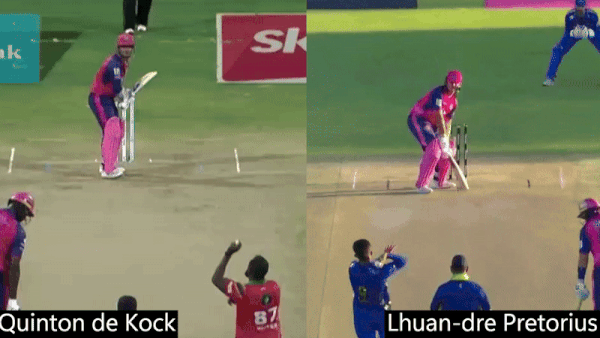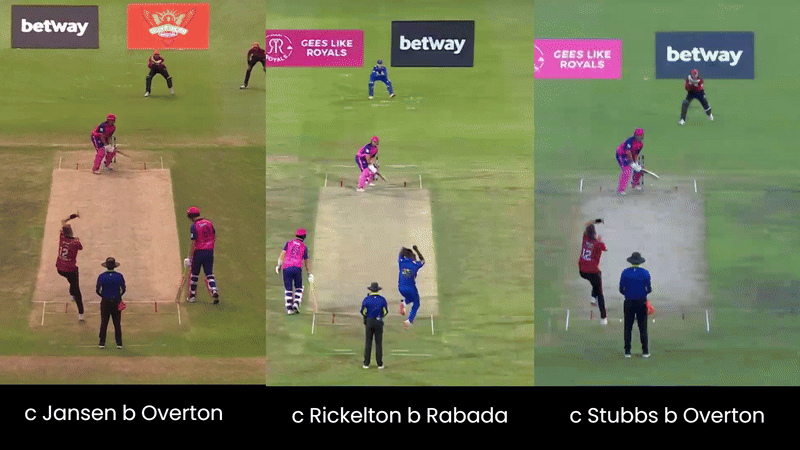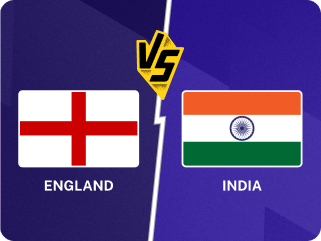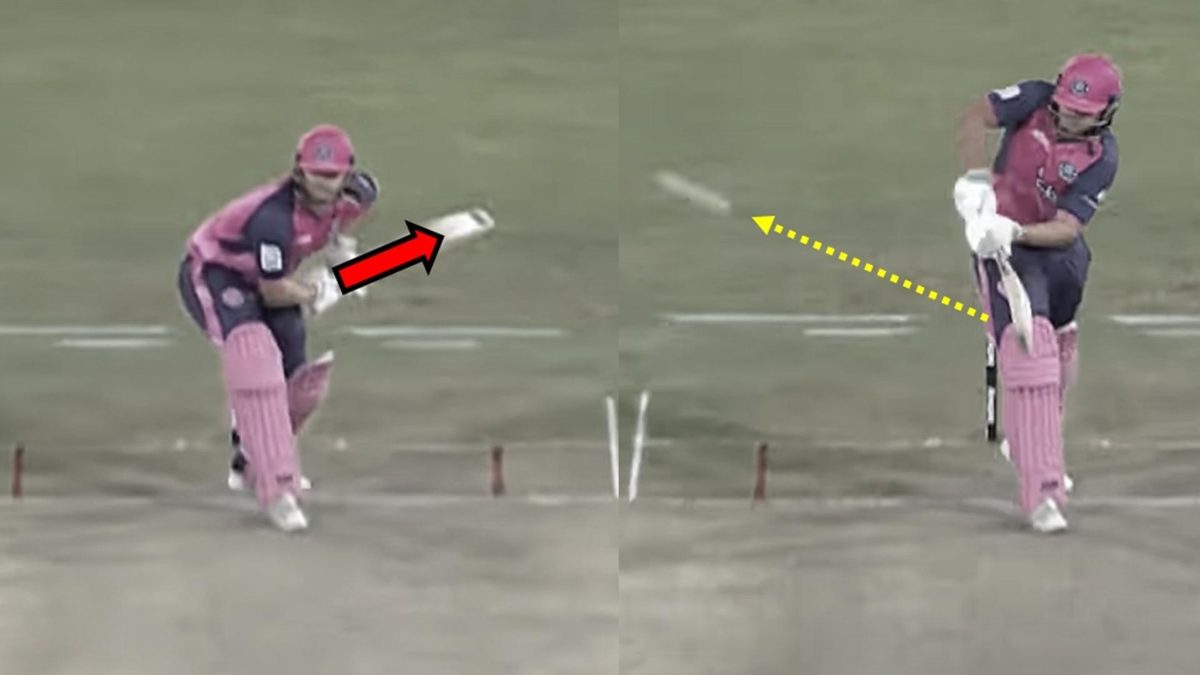
18-year-old opener Lhuan-dre Pretorius stole the show in his debut SA20 season, finishing as the league's top run-scorer. There's every reason to be excited about his future – he is one of T20 cricket's most unique batters at the moment.
A couple of weeks ago, in Qualifier 1 of the 2025 SA20, Pretorius played a flick shot off Trent Boult, which sailed over the leg side for six. The reaction of the commentators told the story: Mark Nicholas could only manage a long-drawn "Ohhhh!" before sputtering "It's unbelievable!" There was involuntary yelp of delight from the back of the commentary box before Nicholas' words, and even two balls later Stuart Broad was marvelling at its effortlessness.
If you are active on social media, chances are the clip has made its way across your feed – a bootleg video of the shot posted on Twitter (now X) garnered over 18,000 likes, 1,700 reposts and 1.3 million views.
It's easy to see the appeal. After all, this was a rookie treating one of the shortest format's most renowned bowlers with utter disdain. It was as if he wasn't even trying on that shot. But even more than that, it neatly showcased in the space of mere seconds, the uniqueness of Lhuan-dre Pretorius' technique in the modern era of T20 batting.
Backlift vs backswing
Like any other aspect of cricket, batting technique has changed over the years. One of the more recent changes has been the prevalence of a high backlift. Archival footage of batters from the 1980s and 1990s will show a significant number of them employing a low backlift, whereas modern batters take the bat up much higher when setting up at the crease.
Read more: Wisden's 2025 SA20 team of the tournament
Note: Backlift is different from backswing. The terms are sometimes used interchangably, but research in this field has made the distinction as follows: backlift refers to the position of the bat before the bowler releases the ball. Backswing, meanwhile, is like a "second backlift" – the initial part of the actual stroke, as the batter "winds up" before making contact with the ball.
Some batters may only raise the bat once, usually as they prepare to meet the ball – in such cases, the backlift and backswing are one and the same.
The idea behind the higher backlift is that it then makes a higher backswing more natural. This adds more power to a batter's shot – an aspect of the game given higher priority in the modern-day, with the rise of T20 cricket. Lower backlifts, meanwhile, are largely considered more suitable for defensive batting, as they ensure the bat can come down sooner to protect the stumps – power is not always important here.
What sets Pretorius apart?
Like most of his peers, Pretorius employs a high backlift – nothing unique there. In theory, this should lend itself to a higher backswing as well.
But here's the catch – Pretorius' backswing is significantly lower than most contemporary batters. Here's how it compares to several of today's top-level T20 batters, with three of his compatriots alongside him in the bottom row (left-handers selected for convenience):
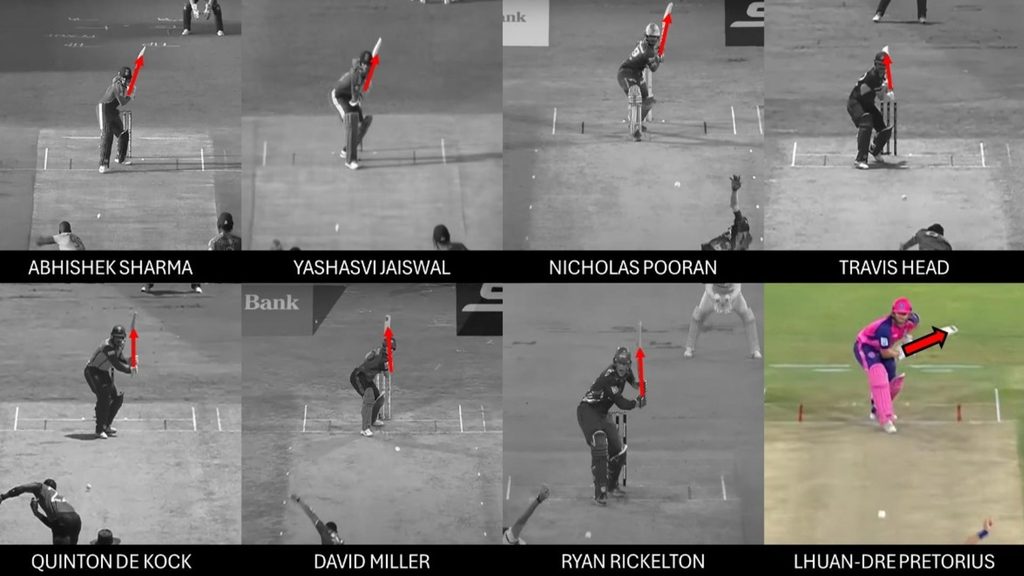
When setting up to hit, most batters bring the bat to an almost vertical position, often behind their shoulder or head. But Pretorius is markedly different. He cocks his wrist, making the bat face point towards the ground (on occasion, almost facing the wicketkeeper), and the blade stick out in the direction of gully.
He's been compared, stylistically, to both Quinton de Kock and Graeme Smith, the latter perhaps more because of his broad frame and strong build. Pretorius himself has said he "sees a bit of himself in de Kock".
The similarities are there, but put them side-by-side attempting a similar shot and the key difference in the backswing really leaps out:
Quinton de Kock vs Lhuan-dre Pretorius: Comparison of set-up and strokeplay
How does this different method work?
Pretorius' technique is quite a significant deviation from the norm. But it would be hard to argue that this is a bad thing. After all, it's fetched him 397 runs at a strike rate of 166.8(!) in his first-ever T20 season – in a league that, quality-wise, is not far off international limited-overs cricket.
Key to all of this coming together is his extraordinary wrist strength, and flexibility.
Because of the angle of the bat face during the backswing, he needs to twist the bat to get it facing the right way in order to meet the ball. It's this jerk, or impetus, that helps him generate power with the wrists, rather than using the height of the backswing like most others do.
Read more: Going hard at hard lengths: How Abhishek Sharma unlocked a different dimension in the England T20Is
The function of the wrists for most batters is like a steering wheel – to help provide direction. At contact, they can flex the wrists either way to make sure a shot goes straighter or squarer of the wicket. It's this flourish that comes through in the bat's follow-through (also making wristy shots pleasing on the eye). But Pretorius uses his wrists for both directing the ball, and generating power.
When facing spin though, he has a higher, more conventional backswing – most likely because he needs the extra power against slower bowlers. The bat also goes a touch higher than usual naturally, when he needs to create room to hit through the off side.
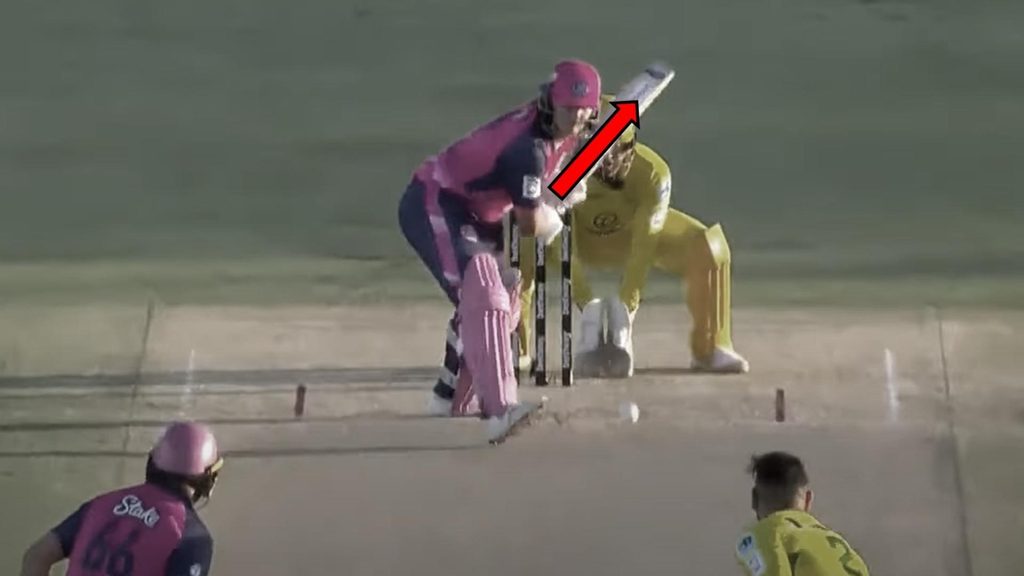
Pros and cons: What does the future look like for Lhuan-dre Pretorius?
It's unclear whether this was consciously trained, or whether this is more or less his natural way of swinging the bat. But Pretorius' unique style has a couple of advantages.
Since the backswing is lower, it means Pretorius can start to bring the bat down to meet the ball later than other players. It's only a fraction of a second, but against quick bowling that can be invaluable, helping him pick line and length with greater surety.
On top of that, the lower backswing could translate well to first-class cricket, when it comes to defensive play – Pretorius can bring the bat down and protect his stumps quicker. Other batters trained and conditioned to a higher backlift and/or backswing may not be able to adjust as easily. The early signs are promising; in his only first-class innings so far, he hit 120, coming in when his side had been reduced to 87-4.
Of course, like any technique though, Pretorius' isn't foolproof. The unique, angle of his backswing means he can often play with a more closed face of the bat compared to other batters, making him very leg-side dominant.
Even a shot as conventionally simple as a cover drive can look slightly more awkward for Pretorius, as the bat has to swing almost inside-out. In the season just gone, only 14.4 per cent of his runs came through the cover region – an area of the field that can often be a high-traffic zone for a left-handed opening batter.
This is what also makes him slightly more vulnerable to right-arm pacers who can operate by moving the ball across him, especially from over the wicket. Opposition teams seemed to have picked up on this towards the end of the SA20, as Craig Overton twice induced an outside edge to dismiss him, and Kagiso Rabada snared him with an away-going delivery from around the wicket.
It should also be interesting to keep an eye on how Pretorius fares against the ball turning away from him, especially in the longer formats – he hasn't quite been tested in this regard on the SA20 wickets, despite the fact that Paarl's home ground of Boland Park was relatively slow and low.
There's no denying that at this point of time, he remains a unique, as well as incredibly exciting, batter in T20 cricket. He did represent the Proteas' U19 side at the last World Cup, and if he continues his current form, might not be far from a senior team call-up in the next 12-18 months.
Pretorius has also signed his next T20 contract, with Hampshire for the upcoming T20 Blast. That will be another stage for him to showcase his immense talent and style – expect him to light up the tournament.
Footage credits: JioHotstar
Follow Wisden for all cricket updates, including live scores, match stats, quizzes and more. Stay up to date with the latest cricket news, player updates, team standings, match highlights, video analysis and live match odds.

